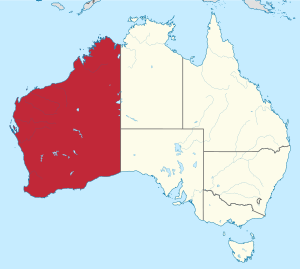
Back Wes-Australië Afrikaans Australia Occidental AN Westerne Australand ANG أستراليا الغربية Arabic ؤسطراليا دلغرب ARY ويسترن اوستراليا ARZ Australia Occidental AST Qərbi Avstraliya Azerbaijani غربی اوسترالیا AZB Ostrali Kawan BAN
Western Australia | |
|---|---|
Nickname(s):
| |
Location of Western Australia in Australia 26°S 121°E / 26°S 121°E | |
| Country | Australia |
| Before federation | Colony of Western Australia |
| Established as the Swan River Colony | 2 May 1829 |
| Responsible government | 21 October 1890 |
| Federation | 1 January 1901 |
| Capital and largest city | Perth |
| Administration | 139 local government areas |
| Demonym(s) |
|
| Government | |
• Monarch | Charles III |
• Governor | Chris Dawson |
• Premier | Roger Cook (Labor) |
| Legislature | Parliament of Western Australia |
| Legislative Council | |
| Legislative Assembly | |
| Judiciary | Supreme Court of Western Australia |
| Parliament of Australia | |
• Senate | 12 senators (of 76) |
| 15 seats (of 151) | |
| Area | |
• Total | 2,527,013[1] km2 (975,685 sq mi) (1st) |
| Highest elevation | 1,249 m (4,098 ft) |
| Population | |
• June 2023 estimate | 2,878,600[2] (4th) |
• Density | 1.11/km2 (2.9/sq mi) (7th) |
| GSP | 2022 estimate |
• Total | AU$377.257 billion[3] (4th) |
• Per capita | AU$135,320 (1st) |
| HDI (2021) | very high · 2nd |
| Time zone |
|
| Postal abbreviation | WA |
| ISO 3166 code | AU–WA |
| Symbols | |
| Bird | Black swan (Cygnus atratus) |
| Fish | Whale shark (Rhincodon typus) |
| Flower | Red and green kangaroo paw (Anigozanthos manglesii) |
| Mammal | Numbat (Myrmecobius fasciatus) |
| Colour(s) | Black and gold |
| Fossil | Gogo fish (Mcnamaraspis kaprios) |
| Website | wa |
Western Australia (WA) is a state of Australia occupying the western third of the land area of the Australian continent.[5] It is bounded by the Indian Ocean to the north and west, the Southern Ocean to the south, the Northern Territory to the north-east, and South Australia to the south-east. With a total land area of 2,527,013 square kilometres (975,685 sq mi),[5] Western Australia is Australia's largest state as well as the second-largest subdivision of any country on Earth, surpassed only by the Sakha Republic in eastern Russia.
Western Australia has a diverse range of climates, including tropical conditions in the Kimberley, deserts in the interior (including the Great Sandy Desert, Little Sandy Desert, Gibson Desert, and Great Victoria Desert) and a Mediterranean climate on the south-west and southern coastal areas. As of 2021,[update] the state has 2.91 million inhabitants—11 percent of the national total.[6] Over 90 percent of the state's population live in the south-west corner and around 80 percent live in the state capital Perth,[7] leaving the remainder of the state sparsely populated. The Trans-Australian Railway and the Eyre Highway traverse the Nullarbor Plain in the state's south-east, providing the principal connection between Western Australia and the population centres in the eastern states.
Western Australia's Indigenous peoples have been present for tens of thousands of years. Dutch explorers visited Western Australia from the 17th century, with Dirk Hartog's 1616 expedition the first Europeans to make landfall. The British claimed Western Australia in 1827 and established the Swan River Colony with Perth as its capital in 1829. The Western Australian gold rushes of the late 19th century resulted in a significant population influx. The colony was granted responsible government in 1890, the last of the Australian colonies to become self-governing, and federated with the other colonies in 1901.
Western Australia's mining sector is a key driver of the state economy. The late 20th century saw the development of the state's significant iron ore mining industry – the world's largest – as well as primarily offshore petroleum and natural gas resources. Gold mining retains a significant presence and many other mineral commodities are mined, with Perth being a major centre for associated services. Outside of mining, primary industry is the other significant contributor to the state's economy, including agriculture in the Wheatbelt and temperate southern coastal regions, pastoralism in marginal grassland areas, forestry in the south-west and fishing (including pearling and, historically, whaling).
- ^ "Area of Australia - States and Territories". 27 June 2014.
- ^ "National, state and territory population, June 2023 | Australian Bureau of Statistics".
- ^ "Western Australian Economic Notes – Gross State Product – 2021-22" (PDF). Archived from the original on 31 August 2021. Retrieved 16 September 2023.
- ^ "Sub-national HDI – Area Database – Global Data Lab". hdi.globaldatalab.org. Retrieved 18 February 2023.
- ^ a b Cite error: The named reference
ga20was invoked but never defined (see the help page). - ^ "National, state and territory population, March 2024 | Australian Department of Treasury". 22 March 2024.
- ^ Cite error: The named reference
ABSCapitalPopwas invoked but never defined (see the help page).
© MMXXIII Rich X Search. We shall prevail. All rights reserved. Rich X Search


